I lied. After writing this up and realizing I had to scroll a lot to get back up, it’s anything but quick. If you’re considering the Q460, hopefully you find it helpful though.
I picked up the NP-Q460 from Best Buy Canada ( both BB and FS list it as a Q460-JS01CA ), as I needed a relatively cheap laptop to replace my previous MacBook Pro, which got owned by a glass of milk. Unfortunately, reviews on this model were slim. As far as the price and specs went, it looked like a pretty solid deal though at $699 CDN so I decided to give it a go.
I’ll assume if you’re reading this you’ve already checked out the specs, but just in case… the short version is that it’s got an Intel i5 2430m, 6GB RAM, nVidia Optimus GeForce GT540m with 1GB mem, and a slow (5400RPM) 640GB hard drive. All the other typical stuff you’d find in every recent laptop is there, though it’s worth noting that it’s got a standard DVD burner (no Blue-Ray).
First some boring unboxing pics, and then some commentary:
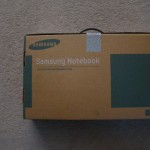
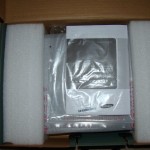
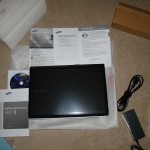
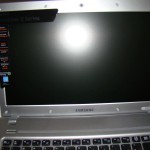
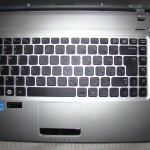
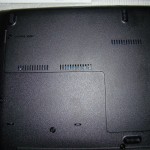
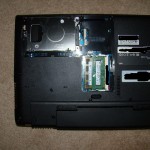
Click on any of the thumbnails above to see the large version in a pop-up window.
—
I’ll sum up a few pros and cons I observed rather quickly for those who just want the ‘gist’ of it:
PROS
| CONS
|
Despite the cons list being longer than the pros list, I’m really quite happy with the system.
Now for a few random details:
—
THE 1 SCREW
The 1 screw you remove to get at the HD/RAM… It’s a small philips screw, and on my notebook it was insanely tight. I tried a dozen small screwdrivers that were all the right size, and it just wouldn’t come.
As it turned out, I had to use a dremel to cut a slot into the screw so that I could use a larger flat screwdriver, get a good grip, and use a pile of force. It was tough, but it eventually came.
I don’t get why:
a) The screw was put in so tight. This is *supposed* to be a user-serviceable panel.
b) They used a smaller screw than they did for the rest of the bottom panel. A larger screw would have fit and would be less prone to stripping.
—
THE FIRST START
The first startup takes quite some time. At first you’re presented with a very well-polished partition manager of sorts that allows you to size (or completely remove) a backup partition of sorts. Takes a few seconds, and is explained well enough that Grandma would probably understand. After that, you wait a good long while as it prepares Windows – I’m assuming that it’s either restoring the Windows image, or installing the whack of trial-ware you’ll spend even more time removing. Waiting for it to finish is like watching paint dry, so go get some coffee. You might even have time to drive to Starbucks. Maybe even the one in the next town.
Once you’re finally at the desktop, you’ll find an Intel utility running in the upper right, letting you know when the CPU turbo’s up. It seems a little out of place (it’s an odd thing to have greeting you), but it can be closed easily enough. Be sure to change the settings before closing it if you don’t want it to auto-run every time the laptop starts.
Despite Norton bugging you pretty quickly, and despite the large number of items in your taskbar, it actually feels like a pretty clean installation (though I’m used to 5-6 programs bugging me on most notebooks during the first boot).
—
THE SAMSUNG PROGRAMS/UTILITES
For the purists out there who have another copy of Windows and like to format/reinstall without the bloatware, be sure to grab the drivers from Samsung’s site first (the Samsung tools/utilities are also available there).
For the other minimalists who simply tend to uninstall the trialware they don’t want/need, don’t go uninstalling all the Samsung-related stuff. Some of it’s useful (check the installed manual to see what each does). You don’t need all of it, but a few things (like the software that enables keyboard features) you’ll probably want. That said, if you find you’ve removed something you want back, you can grab it again on Samsung’s site.
—
TEMPERATURES
Using OCCT and FurMark, I tried to get a rough idea as to what temps I’d be looking at.
Both the CPU and GPU could be nudged to the 80-85 degree C region (GPU goes a little hotter than the CPU). I’m guessing they have independent heatsinks, though I’ll confirm this when I disassemble the thing. The fan doesn’t start really kicking up until the 80 degree mark, though at that point, it’s still much quieter than my previous MacBook Pro.
The temps are a bit worrisome – intense games are probably going to get the thing hot, and based on previous experiences, after dust has had a couple months to accumulate I wouldn’t be surprised if either the CPU or GPU started to hit over 90 degrees.
Since I don’t want to be the victim of throttling or system shutdowns, when I disassemble the notebook, I’ll probably take a look at the airflow design, heatsinks & heatsink paste and see if something can be done.
GAMING
The only game I’ve tried so far has been BioWare’s MMO, SWTOR (Star Wars: The Old Republic). Played around for a couple minutes at the fleet station. TOR is known for being fairly demanding – if you browse the forums you’ll find many complaints pertaining to low fps, particularly by laptop users. It’s also notorious for pushing the CPU/GPU when it comes to heat output. Again, you’ll find many complaints about users who have systems shutting down, crashing, throttling, and restarting due to heat while playing this game.
I was interested to see how the notebook fared in terms of both fps and heat when playing at the native resolution.
At high settings, the game tends to sit a little above the 10fps mark. Technically playable, but not really practical.
At low settings (though with shadows off completely as well), the framerate becomes respectable, hitting 60fps at times, and generally bottoming out at just above 30fps. Movement is fluid, and I’d expect combat should remain fluid as well.
I didn’t try out medium settings, as most people will probably benefit from tweaking the individual settings and finding which give the most benefit when it comes to the quality/fps tradeoff.
After about 10 minutes on the fleet station, I took a look at the temperatures. The nVidia 540m had topped out at 71 degrees C. The CPU had capped at about 84 degrees C. When I disassemble the laptop I’ll see if new heatsink paste results in a reduction.
For being a low-medium card, the GeForce 540m looks to be more-than-adequate for casual gaming, and as a whole the Samsung Q460 notebook should be just fine for those who may use it for periodic gaming.
I wouldn’t call the Samsung Q460 a gaming laptop by any means, but if you’re content to get good framerates under low quality settings, I doubt it will disappoint.
—
TO SUM IT UP
It’s a good laptop, and a purchase I’m quite happy with. At around $700, The Samsung NP-Q460 is a fantastic compromise between the $300-500 budget-laptops that can barely game, and the $1000-1500 laptops that game well but at a high cost.
I may pop in an SSD one of these days, and will definitely be replacing the RAM with 2x4GB sticks that I have kicking around.
At the time of this writing, the only laptop that would give the same specs for less money would be an Acer for around $50 less, but I’ve never been pleased with the build quality of Acer’s stuff.
Anyway, that concludes the review. If you bought a Samsung Q460-JS01CA and have thoughts to share, feel free to leave them in the comment section below.
For now, my only issue with this machine is the trackpad. Out of the box, the drivers weren't loaded. I had to download directly from Synaptics to get it working. But two-finger scrolling has never worked properly, either jumping down pages at a time, or not scrolling at all. It's frustrating. I never realized how good Macbook users had it.
As for gaming, I play SW:TOR on High settings and get very good frame rates. I had to adjust the nvida optimus thing to recognize SW:TOR. The laptop was dropping down to the Intel graphics, which was unplayable on "high". But once I messed with things, I run very smooth on High (with just 1 or two items adjusted).
Once again, if you close the laptop and look at the top of it, right in the middle it's like a little ridge, a line that pops out right in the middle of it.
Just checked, and nothing I could see (or feel). On mine, there's a zaggy-grey-line design on the top though, so it's possible that it's being masked if it exists.
Samsung appears to have dropped it from the main page too and gone onto the q500 series
I certainly did pull it apart!
https://mattgadient.com/replacing-thermal-paste-on-the-samsung-q460-and-disassembly-pics/
None of the usual utilities can detect the fan.